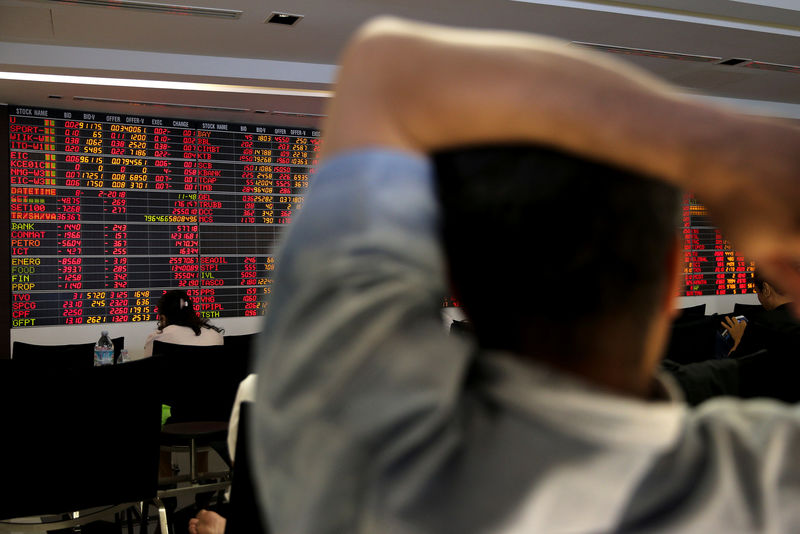By Vidya Ranganathan
SINGAPORE (Reuters) - If this week's selloff in global equity markets is any guide, then Asia's frothy debt and stock markets have reason to be on edge over the steady rise in long-term U.S. bond yields that could push up global funding costs and drive capital out of the region.
A whiff of inflation in the United States sent global stock markets tumbling in the past week, wiping 7 percent off Asian equities, despite a still supportive backdrop of robust global growth, a weak dollar and rising company earnings.
Bond and currency markets were relatively unaffected, as they have been through the Federal Reserve's slow pace of policy rate rises since 2015 and more recent reminders from central banks in Europe and Japan about dialling down on stimulus.
So far, long-term dollar yields have also stayed low, keeping a lid on funding costs for investors who have pumped billions of dollars into high-yielding emerging market assets.
But U.S. 10-year Treasury yields are creeping closer to 3 percent, where analysts say the current "Goldilocks" scenario of a strong economy and muted inflation would give way to fears of peaking growth, rising inflation and more rapid policy tightening.
"Our concept of Goldilocks is around a pretty modest rise in U.S. yields," said Daniel Morris, a senior investment strategist at BNP Paribas (PA:BNPP) Asset Management. "A rise to 3 percent or so wouldn't be quite so benign. That would upset this Goldilocks view."
Ten-year Treasury yields were falling through most of 2017 even as short-term dollar rates climbed. They spiked above 2.8 percent for the first time in 3 years last week, and have risen 50 basis points since November.
Investors would read a 3 percent mark on 10-year Treasuries as a situation in which U.S. inflation is accelerating, the Fed would have to raise rates faster and markets globally would be jolted, Morris said.
Complicating matters is the U.S. dollar, which has steadied this month after 13 months of a slow grind lower. The weaker dollar had provided foreign investors an added reason to stay invested in the appreciating Asian currencies.
"Emerging markets have become much more sensitive to the long end than the short end of the U.S. yield curve," said Frederic Neumann, co-head of Asian economic research at HSBC.
That was primarily because much of the money that has flowed into Asia since the global financial crisis a decade ago is real money whose funding costs are based on long-term yields, rather than investors loaded up on short-term leverage, he said.
"So if you have the U.S. 10-year at 2.3 percent, it still makes sense to invest your money in Indonesia. If the 10-year trades at 3.3 percent, the investment in emerging markets will probably need to be repriced."
NOT ANOTHER TAPER TANTRUM
The five markets of Indonesia, Malaysia, South Korea, Thailand and India received net bond inflows of around $49 billion in 2017, while the flows to seven of the biggest emerging Asian stock markets were less than half that amount.
So far these bond markets aren't pricing in any major monetary tightening by local authorities, hence most of them are not too correlated to U.S. yields. Even yields on dollar-denominated bonds issued in Asia have been capped by narrowing spreads over Treasury yields.
Investors in some markets will have more cushion as U.S. yields rise, such as those in Indonesia's 10-year bonds that fetch 6.4 percent and India's at 7.5 percent. The more vulnerable are those in markets where 10-year yields are about the same as U.S. Treasuries, such as South Korea and Thailand.
As Treasury yields rise, emerging market investors will be forced to assess whether they are simply being compensated for the higher inflation or being paid to take on additional risk, said Maurice Meijers, CEO for Singapore at Robeco Institutional Asset Management.
"A lot of market participants are not pricing in risk in their search for yield. Once Treasury yields rise dramatically, that would hurt things from a sentiment perspective," Meijers said.
Most fund managers think a slow grind higher in U.S. yields may cause less pain for emerging markets, at least far less than the turmoil during the 2013 taper tantrum, when the Fed first dropped hints of reducing its crisis-era stimulus.
Still, they worry that investors are complacent.
Alain Bokobza, head of asset allocation at Societe Generale (PA:SOGN), said investors should "prepare for the end of Goldilocks."

"At 2.9-3.0 percent on the 10-year Treasury, global markets and emerging markets would start to be really worried," he said, describing that level as a threshold at which there would be worries about destabilisation in the United States possibly causing an attack on the U.S. bond markets, and raising big questions about the sustainability of U.S. growth without inflation.